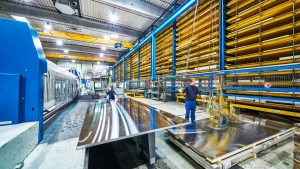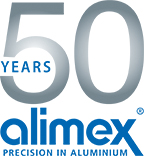The cast aluminium plate is hugely important for the industry: Machine, plant and mould construction, as well as the optical industry and many others benefit from the properties of the cast aluminium plate: extremely low stress, excellent dimensional stability and savings resulting from no distortion, less waste, faster processing times and the prevention of additional annealing. In addition, of course, the cast aluminium plate has all the classic advantages of aluminium: its easy to machine, easy to recycle and low weight. A double win for the user! In certain applications, the aluminium cast plate has almost completely displaced the conventional aluminium plate.
alimex -pioneer of the aluminium cast plate process
The aluminium cast plate process was invented by alimex in Willich. According to Marc-Wilm Lünemann, head of the CNC business unit at alimex, in the 1970s, alimex founder Helmut Geller had the idea of slicing the raw material for both roll-bonded plates and cast plates (the so-called rolled bars) “like a sandwich”. “Since then, the process has been continuously developed by us in Willich, and we have become a sought-after specialist around the world whenever the incomparable advantages of aluminium are required.”
What is the difference between roll-bonded and cast plates?
Roll-bonded plates are produced by rolling down the starting material in rolling mills to the desired plate format. During this process, enormous stresses and directional properties are forced into the material. These can only be partially eliminated in the further production process, and what’s more it’s a laborious task. Aluminium cast plates works are produced in a completely different way. After heat treatment, the starting material is sawed with special panel saws. As a result, the plates have no direction-dependent properties, but an almost homogeneous structure and relatively identical properties across the whole plate surface.
The advantages of the aluminium cast plate in further processing
This consistent strength of the cast plate makes it easy for the cutting mechanic, who manufactures precision components from the cast aluminium plate – because he does not have to pay attention to changing stresses or strength conditions and therefore does not have to continuously adjust the parameters set in the mill. This reduces both the processing times and the tool wear. Aluminium cast plates from alimex ensure outstanding material properties for aluminium semi-finished products and components of any size – allowing alimex to help their customers secure competitive advantages.
Where are these plates and components made from them used?
Mechanical and plant engineering – where high-precision aluminium solutions are needed. The material properties that are particularly in demand in these sectors, such as the robustness of the material, low weight and good machinability, are produced by targeted machining of the material with the aluminium cast plate process. The use of aluminium treated in this way allows efficient and cost-effective applications, even with complex geometries.
alimex also supplies precision parts and plates to the optical industry. In particular, a special milling technique guarantees mirror-smooth precision cast plates of optically impeccable quality. This won alimex the European Aluminium Award.
Likewise, the solutions that alimex has developed for mould and prototype construction are based on the aluminium cast plate process. They are characterised by excellent tension and cutting properties as well as high strength properties – everything typical of cast aluminium plate!


